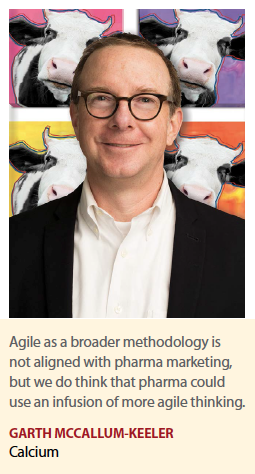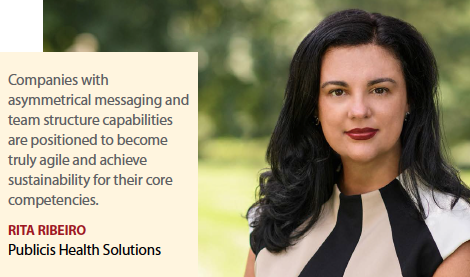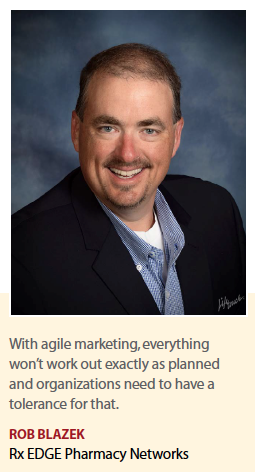Agile methodology is all about leveraging experiences and failures to improve a process, and has been adopted across industries and entities to organize everything from software development to household chores and family activities. Rooted in IT, the agile manifesto has been adopted by winemakers, tractor manufacturers, public radio, and parents. By taking people — employees or family members — out of their functional silos and putting them in self-managed and multidisciplinary teams, the agile approach creates a method of quickly completing tasks with the flexibility to make necessary changes on the fly.
From scrum (the framework for managing complex processes) to sprints (time periods set to get tasks done), to kanban boards (workflow visualization tools), the agile lingo may be unfamiliar, but the concept is beginning to take root among life-sciences marketers.
 Garth McCallum-Keeler, managing partner, chief strategy officer at Calcium, aptly describes agile as a methodology that grew up in the digital and software development space and has been migrating recently to broader consumer marketing. As practiced in the digital space, agile brings together cross-disciplinary teams overseen by a leader — a “Scrum Master" in the most commonly used model — who is empowered to look across channels and disciplines and make decisions with a minimum of outside involvement. These teams are designed to drive rapid, iterative change — make small adjustments or additions quickly, measure successes or failures, adjust accordingly, and move on to the next iteration.
Garth McCallum-Keeler, managing partner, chief strategy officer at Calcium, aptly describes agile as a methodology that grew up in the digital and software development space and has been migrating recently to broader consumer marketing. As practiced in the digital space, agile brings together cross-disciplinary teams overseen by a leader — a “Scrum Master" in the most commonly used model — who is empowered to look across channels and disciplines and make decisions with a minimum of outside involvement. These teams are designed to drive rapid, iterative change — make small adjustments or additions quickly, measure successes or failures, adjust accordingly, and move on to the next iteration.
According to a Harvard Business Review report, agile offers a number of major benefits compared with traditional approaches, all of which have been studied and documented. By improving visibility and continually adapting to changing priorities, agile improves engagement, brings the most valuable products and features to market faster and more predictably, and reduces risk. An important element of agile is to engage team members from multiple disciplines as collaborative peers, as that broadens organizational experience and builds mutual trust and respect. The big question is: With its regulatory constraints and its unwieldy organizational structure, can pharma marketing even be agile?
Pharma Needs to be Agile, But Can It?
In today’s world, and more so in the ever-challenging environment of tomorrow, pharma marketers will need to respond rapidly to both market events and the needs of their stakeholders — payers, patients, and physicians.
Agile marketing involves short-term planning and speedy execution cycles — typically a few weeks — that are designed to give marketing teams more visibility and flexibility in prioritizing tasks and meeting goals. Using the bite-sized decision-making approach of agile in marketing allows an iterative process that can quickly course correct and be on target far more effectively.
Agile, in the marketing context, means using data and analytics to continuously guide promising opportunities or solutions to problems in real time, deploying tests quickly, evaluating the results, and rapidly iterating.
According to global consulting firm Mc-Kinsey, a high-functioning agile marketing organization operating at scale could run hundreds of campaigns simultaneously and produce multiple new ideas every week.
However, that high level of agile performance is most likely beyond the capabilities of pharma companies, due to a number of challenges. Some experts even doubt that pharma can fully embrace an agile process across all its marketing objectives.
“The present structure and history of pharma marketing teams is oriented away from anything like agility," Mr. McCallum-Keeler says.
“Even though at Calcium we don’t think agile as a broader methodology is aligned with pharma marketing in general, we do think that pharma could use an infusion of more agile thinking, and that is going to require some change."
“I think it will be a while before the industry adopts agile, but I think the change in pharma thinking will begin as soon as next year," says Pratap Khedkar, managing principal, ZS Associates. “A few pharma companies are already in the process of trying to change how they work."
An Agile Mindset
There are several challenges facing the industry in its adoption of agile, but three stand out: overcoming the traditional mindset, working around organizational structure, and coping with the slow pace of regulatory review.
 These challenges may prevent a fully implemented agile process, but the industry should still be adding agile tactics where it can to keep up with the speed of how the world around it is moving.
These challenges may prevent a fully implemented agile process, but the industry should still be adding agile tactics where it can to keep up with the speed of how the world around it is moving.
A significant hurdle lies in whether the traditional marketing culture or mindset can be shifted to accept that an agile process is actually better. Since the “old way" is still working in many ways, and has for many years, there is a natural resistance to change.
“The major challenges to achieving an agile mindset are breaking away from structured practices that have made marketers successful historically, creating a team that can rapidly collect, analyze, and develop actionable plans, and developing a diverse cache of tactics that can be accessed and rapidly deployed in a short time frame when transient opportunities surface," says Rita Ribeiro, senior director, marketing and communications, Publicis Health Solutions.
“The most significant challenge I see in developing an agile mindset across the marketing organization is creating the willingness to be bold and not just do what has always been done," says Rob Blazek, R.Ph., senior VP, networks and analytics, Rx Edge Pharmacy Networks.
“Someone with an agile mindset is willing to make an informed decision in a tight window rather than take weeks to reach that decision."
There also has to be a culture of learning from past mistakes and moving on, he adds. The point of agile is that everything won’t work out exactly as planned, and organizations need to develop a tolerance for that.
Mr. Khedkar agrees, saying marketers must become comfortable with making decisions with uncertainty, because if they spend six weeks analyzing a decision, the window of opportunity will close by the time they can take action.
The point behind agile is to learn from failures, and course correct quickly, instead of spending a lot of time and energy trying to make the perfect decision for some event that may happen in the distant future.
“With agile, it’s okay to make a small misstep for the short term, because two months later it can be corrected," Mr. Khedkar says. “So there is less of a penalty to being wrong with agile. This contrasts greatly with traditional thinking, which was that if you couldn’t make a correction for two years and you got something wrong, it was going to be very costly and cause a lot of damage. So marketers had to spend a lot of time envisioning all the things that might happen for up to two years. This legacy mentality will be one of the hardest things for pharma marketers to overcome."
The Challenging Organizational Structure
Pharma marketing teams can certainly learn from the agile model and incorporate the ideology into their planning, Mr. McCallum-Keeler says.
“Executing in alignment with agile principles in the pharma context may be feasible, albeit with some caveats," he says. “The entire structure of internal marketing teams would have to be re-thought in a way that amplifies a cross-disciplinary style, but also assigns a lead — the Scrum Master — who has the authority to make autonomous decisions."
Given the immense amount of data collected today that gives marketers insight into the success or failure of their tactics in real time, they should be measuring and adjusting to the maximum degree allowable within the regulatory constraints.
But going fully agile, as with the digital consumer world, is not likely, he says. There is too much of a market and organizational mismatch.
The problem, Mr. McCallum-Keeler says, is that internal pharma marketing teams simply aren’t built to be agile — there’s too much separation between the brand lead, the strategists, the functional leads, and the digital people.
Bottleneck of Regulatory
Regulatory constraints can quickly put the full stop on agile, as its operations remain glacially slow.
No matter how quickly everyone else can make decisions, if those decisions can’t get through legal quickly, the whole purpose of agile falls apart.
As long as the legal department is required to review and approve every piece of material even when only the smallest strategic or tactical change is made, agile will not get the opportunity to live up to its potential. Even if all the other systems can react in real time, such as IT, data collection and analysis, and sales rep messaging, as long as the medico-legal review slows the process, it will create a bottleneck and all the speed — the whole purpose of agile — will be lost.
All functions must be agile, or else none will be.
“The legal and regulatory framework and processes inside pharma companies are still fairly antiquated and geared to the past world," Mr. Khedkar says. “This is a big issue stopping many large pharma companies that are very conservative from adopting agile."
“Pharma marketers will not be fully agile in any future we can foresee," Mr. McCallum-Keeler says. “The rate limiter that we call the regulatory process is always going to make agile marketing in pharma a bit of an oxymoron."
Despite these challenges, some pharma marketers are starting to think about moving to a more agile approach and are much more aware of the benefits, Mr. Khedkar says.
“Many companies have a high level of interest and there’s much more receptivity to it today," he says. “We find ourselves discussing an agile approach with the C-suite level, and they understand the concept and want to implement it. But within the hierarchy, I think there are some nitty-gritty challenges."
Launch Rooms and Breaking Silos
The process of agile can be summed up in three steps: anticipate, decide, and act. And to capitalize on those actions faster, some pioneering pharma marketers are developing ways to break down the communication silos to foster an agile approach.
“The new paradigm of the future is to imagine a room where all three of these activities happen together," Mr. Khedkar says. “We call it a launch room."
At ZS Associates, the company has implemented launch situation rooms for post-launch analysis to take place in real time. Instead of every sector doing its research in separate offices and then communicating the results every couple of weeks with a PowerPoint presentation in a meeting with other stakeholders, Mr. Khedkar’s idea was to put all the players in the same room — the brand team, the analysts, market researchers — and as they collect the data, instead of developing reports, they participate side by side in intense working sessions that occur every few days. During these sessions, the information is reviewed and everyone in the room speaks to how the group should respond to what the data are telling them.
“The process becomes much more centralized with all the people in the room, so they’re not working within an individual mindset but rather a group mindset, which changes how they function," he says. “This lack of silos is really important; otherwise, it just means getting reports faster, but it still takes a long time to communicate the intel from one group to another."
Similarly, Ms. Ribeiro says marketers need to redefine relationships with stakeholders in the organization and vendor partners in order to create an accessible pool of SMEs (subject matter experts) and tap into real-time data to quickly execute analytics and drive action plans.
“They also need to apply analytics and mine data across multiple streams, such as consumer and predictive analytics, to quickly identify and react to opportunities," Ms. Ribeiro says. “In parallel, marketing teams need to increase collaboration with industry leaders who can bring cross-industry knowledge to build customer experience capabilities."
Mr. McCallum-Keeler believes that the present structure and history of pharma marketing teams is oriented away from anything like agility. However, certain parts of the methodology can be incorporated to improve the speed and accuracy of decision-making.
Given the growing capability marketers have to measure the impact of their efforts and the increasing number of media in which those efforts are appearing, centralized teams are necessary for monitoring and reflecting on all the feedback from every channel.
“In real agile marketing there are cross-functional teams with leaders — Scrum Masters — who are empowered by the organization to move quickly and make decisions without much outside input," Mr. McCallum-Keeler says. “We’d like to see a similar approach taken in pharma, even if the outcome never quite gets to new content every few weeks."
Marketers need to know how all the channels are working together as a whole, how they are operating or not operating in concert, whether the content flowing through each channel is truly optimized, and perhaps most importantly but often overlooked in pharma, how the consumer is reacting to the content mix.
“In order to effectively execute all of these factors, we will have to reconstruct the entire way our marketing teams are built, to make them far more cross-functional and empower them to make choices without having to go through layer upon layer of signoffs," Mr. McCallum-Keeler says. “We need people with decision-making authority to be engaging with the data across channels and responding to it on a day-to-day basis. This is going to be a challenge. But it’ll also be a great investment in the effectiveness of our marketing, not to mention the education of our future leaders."
Factors Driving Agility
According to ZS Associates, there are three factors creating greater need for agile marketing practices in pharma. One is that the number of market events has increased; some brands can have up to 11 launches in their category in one year.
“Part of the agility push is there’s just so much happening all the time, as opposed to in the old world of pharma where, after a launch, there might be a competitor every three or four years and marketers have to prepare for this, but there weren’t big shocks to the system as often," Mr. Khedkar says.
The second element is that product launches are often met with many challenges and struggles today. There are more fires to put out during launch, and marketers need to get to the bottom of a problem sooner — like in two months, instead of the traditional two years, to course correct.
“Pharma companies didn’t have to worry about this so much even five years ago, but they absolutely do today," Mr. Khedkar says.
 Third, companies are realizing that forecasting future outcomes is much more complicated today, and that spending the time to try to determine all the possible scenarios and prepare for them is a lot of work that does not result in any solutions necessarily.
Third, companies are realizing that forecasting future outcomes is much more complicated today, and that spending the time to try to determine all the possible scenarios and prepare for them is a lot of work that does not result in any solutions necessarily.
“There are some companies beginning to accept that they need to be able to react quickly and adapt for the next three to six months and be able to course correct as they go," Mr. Khedkar says. “That is a much better way of handling volatility in the future than to worry about all the possible ways the future may evolve, because that’s a lot of thinking without a lot of action."
Pharma is seriously questioning the practice of waiting for six to nine months to find out how a launch or campaign is going, when using technology and an agile approach, changes can be made in a matter of weeks instead of months. Getting the feedback from the data doesn’t do any good if it comes too late to make any changes.
“The focus has now shifted much more to acting on data as opposed to having a long-range plan in place that does not have the flexibility to be changed," Mr. Khedkar says. “That is the essence of how agility should be manifesting itself within the industry."
As the industry continues to strive to become more agile in the face of building market pressures, it will have to shift its focus from the product to addressing customer needs, Ms. Ribeiro says.
“Pharma companies will be on the right path to agile marketing track only when they have made the paradigm shift from a centrally driven approach of marketing products to the point of focusing on customer experience and rapidly addressing customer needs," she says. “Companies with asymmetrical messaging and team structure capabilities are positioned to become truly agile and achieve sustainability for their core competencies."(PV)
~~~~~~~~~~~~~~~~~~~~~~~~~
Medical Affairs 2.0: Agility Can Enhance Medical Affairs
Medical affairs professionals are embracing newer solutions that help them respond to rapid changes.
Joseph Laudano, Medmeme
 New advances in medicine and communications technologies build new expectations to effectively communicate science in newer ways, rapidly responding to changes in the scientific and competitive landscape. This is Medical Affairs 2.0. Medical affairs professionals now need to be more agile with the information they work so hard to develop.
New advances in medicine and communications technologies build new expectations to effectively communicate science in newer ways, rapidly responding to changes in the scientific and competitive landscape. This is Medical Affairs 2.0. Medical affairs professionals now need to be more agile with the information they work so hard to develop.
This requires medical affairs professionals to have:
An agile mindset to make quick, strategic changes in communicating science in response to data gaps, new developments, and the scientific needs of the medical community.
Metrics to accurately assess the impact of their efforts.
Analytical solutions developed specifically for medical affairs professionals.
Nontraditional communication venues and metrics that were impossible a few years ago are being employed routinely by forward-thinking medical affairs professionals who understand the need to respond in an agile way in terms of data generation and communications.
Regularly checking current metrics regarding key influencers, fine-tuning and continually updating contact lists, and reprioritizing activities are critical to successful MSL plans.
Medical affairs analytics can automate this work, enabling fresh, comprehensive insights over current information.
One company using this approach reports its field medical staff reduced the time required to prepare for meetings with scientific contributors by one-third. Less time was spent doing searches to determine which thought leaders were appropriate for which specific needs. Consequently, its MSLs knew who merits more effort or less, which lets them engage with experts more accurately based on their shared scientific imperatives. The result is greater productivity and improved communication that puts information into the hands of those who will use it to optimally enhance patient care.
The medical affairs organization itself must be agile. Real-time alerts to new scientific developments presented at conferences, for example, are wasted if they’re not reviewed promptly. Agile medical affairs departments disseminate intelligence quickly to adjust plans.
That means contacting the right opinion leaders, generating data based on gap analyses, ensuring scientific imperatives are communicated at the right time and place, and strategically balancing content dissemination versus the competition.
Medical Affairs 2.0 analytics help professionals do all this and more, but medical affairs analytics aren’t yet mainstream.
The technology and very concept of having an analytical platform dedicated specifically to medical affairs are relatively new, and the capabilities are still growing. But, so are the pressures to do more faster and more effectively than ever before.
In this just-in-time world, accustomed to instant information, the pressures on this mission-critical function will only continue to increase.
As the demand for instant access to timely data grows, medical affairs analytics will move into the fast lane and, inevitably, transform this function into a more agile specialty.

















